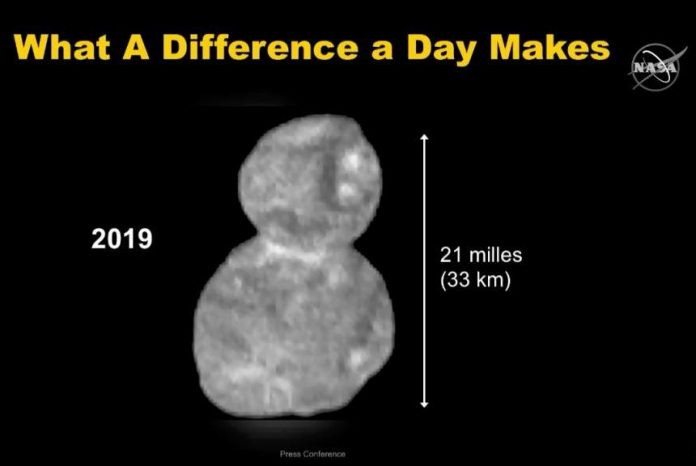Jan. 3 (UPI) — New images and data returned by the New Horizons probe prove Ultima Thule is a snowman-shaped contact binary, the first to be explored by a spacecraft.
Early on New Year’s Day, New Horizons passed within 2,200 miles of Ultima Thule — the most distant planetary flyby in history. The Kuiper belt object is currently 4 billion miles from the sun.
Scientists weren’t able to confirm the flyby until several hours later. It takes a long time for data to travel million of miles across space — and the first images downloaded by NASA scientists showcased only a fuzzy peanut-like shape.
On Wednesday, NASA scientists shared newly downloaded data revealing the distant object at greater resolutions. The new images and data confirmed the icy space rock’s classification as a contact binary.
“It’s two completely different objects that are now joined together,” Alan Stern, the principal investigator for the mission, said during Wednesday’s briefing.
Though Ultima Thule formed a long time ago, it remains pristine, seemingly unmarked by craters. Because it is so far from the sun, it remains in a deep freeze. Scientists think the object could contain the chemical signatures of the early solar system.
“Everything that we’re going to learn about Ultima — from its composition to its geology, to how it was originally assembled, whether it has satellites and an atmosphere, and that kind of thing — is going to teach us about the original formation conditions in the Solar System that all the other objects we’ve gone out and orbited, flown by and landed on can’t tell us because they’re either large and evolve, or they are warm,” Stern said. “Ultima is unique.”
In the coming days, weeks and months, NASA scientists will continue to receive new data from New Horizons, revealing Ultima Thule in greater detail. New images from varying perspectives — captured as the probe moved passed the object — will bring out shadows on the object surfaces, revealing its contours more clearly.
Scientists think New Horizons has enough fuel to visit one more object in the Kuiper belt within the next decade. Mission scientists are working on additional funding. For now, researchers have plenty of Ultima Thule data to decipher.




